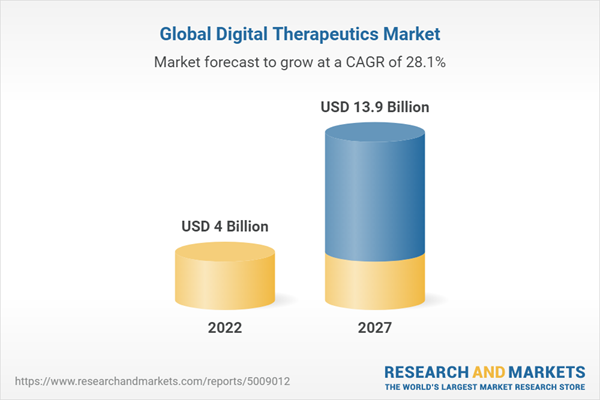The current report covers the booming technology of digital therapeutics. It also investigates the current shift in trends away from conventional methods of treatment toward the advanced means offered by digital therapeutics. This report is an update of an earlier report of the same title but focuses on more in-depth information. This report offers a comprehensive analysis of the global digital therapeutics market. Segmentation is based on application and sales channels. Based on application, the market is segmented as diabetes, psychiatric and addiction, neurological, cardiovascular diseases, and others. Based on sales channel the market is segmented as business-to-consumer (B2C) and business-to-business (B2B). The regional markets covered are North America, Europe, Asia-Pacific, and the Rest of the World (RoW). For market estimates, data has been provided for 2019, 2020, and 2021 as the base year, 2022, and a forecast for 2027.
The report provides a detailed overview and analysis of the present and future global market for digital therapeutics. Industry growth drivers, restraints, and opportunities are also discussed in detail. The report also provides a competitive landscape, elaborative company profiles, and the impact of COVID-19 on the market. The report focuses on the companies that are developing and encouraging digital therapeutics technology and doing research to develop the technology further.
Report Includes
- A brief general outlook of the global market for digital therapeutics scenario
- Analyses of the global market trends, with market revenue data from 2019 to 2021, estimates for 2022, and projections of compound annual growth rates (CAGRs) through 2027
- Highlights of the current and upcoming market potential for digital therapeutics, and areas of focus to forecast this market into various segments and subsegments
- Updated information on market opportunities and drivers, key shifts and trends, regulations and industry specific challenges, and other factors that will shape this market demand in the coming years (2022-2027)
- Identification of the companies best positioned to meet the demand owing to their proprietary technologies, product launches, mergers and acquisitions, and other market strategic advantages
- Review of the technology landscape for digital therapeutics marketplace with emphasis on recently approved products as well as products under development or in different stages of clinical trials
- Profile descriptions of the market leading participants, including Big Health, Happify, Omada Health Inc., Pear Therapeutics and Welldoc
Table of Contents
Executive Summary
Digital therapeutics (DTx) is considered a subset of digital health. These are evidence-based, innovative interventions in which the therapeutic activity is based on algorithms and software. These interventions can be a standalone treatment or used in combination with the current medications.
Digital therapeutics are highly customizable tools and hence the growing demand for personalized and preventive treatment will be a driving factor for the market. The tool allows better involvement of the patient in the management of the disease. Thus, this technology provides an opportunity to cater to the chronic diseases segment.
Chronic diseases create a significant burden on the healthcare system in terms of morbidity and finances. Since the majority are lifestyle-related disorders, modifications in lifestyle will help to prevent or reduce the burden of the diseases. An example of this is prediabetes prevention, where DTx tools will help to prevent or delay the diagnosis of the disease. DTx also provides digital cognitive behavioral therapies (CBT), which are required for psychiatric indications such as post-traumatic stress disorder (PTSD), attention-deficit/hyperactivity disorder (ADHD), and depression. Due to the pandemic, the prevalence of these psychiatric disorders has also increased. Thus, the increasing prevalence of chronic
conditions and the increasing burden of the healthcare system will lead to increased adoption of digital solutions. Compared to traditional drug development, the cost of developing digital therapeutics is relatively low.
The other factors contributing to the growth of the market include increasing investment in digital health and digital therapeutics, growing research activities, and the increasing use of smartphones, mhealth apps, and wearables. It is observed that initially only academic and tech companies were involved in the development and research of digital therapeutics. But the increasing investments in this space have attracted a number of pharma and other players in the market. The market has a number of small players and start-up companies and is expected to witness the entry of other players in the future, as many companies have ongoing pivotal trials in their portfolio.
Since this market is in its nascent stage, there is a lack of regulatory and reimbursement guidelines. Hence, developing proper regulatory and reimbursement frameworks will attract more users to the market.
Players in the market include Pear Therapeutics, Click Therapeutics, Akili Interactive, Omada Health, Big Health, Voluntis, Propeller, and others.
In this report, the market is segmented based on application, sales channel, and region. The North American market currently holds the highest market share, followed by Europe. This leadership role is due to the increasing prevalence of chronic diseases in the U.S., increasing investments, rising demand for cost-effective and patient-centric solutions, and increasing awareness.
Companies Mentioned
- Akili Interactive Labs Inc.
- Big Health
- Click Therapeutics
- Happify
- Omada Health Inc.
- Orexo Ab
- Pear Therapeutics
- Propeller Health
- Voluntis
- Welldoc
Table Information
| Report Attribute | Details |
|---|---|
| No. of Pages | 61 |
| Published | November 2022 |
| Forecast Period | 2022 - 2027 |
| Estimated Market Value ( USD | $ 4 Billion |
| Forecasted Market Value ( USD | $ 13.9 Billion |
| Compound Annual Growth Rate | 28.1% |
| Regions Covered | Global |
| No. of Companies Mentioned | 10 |









